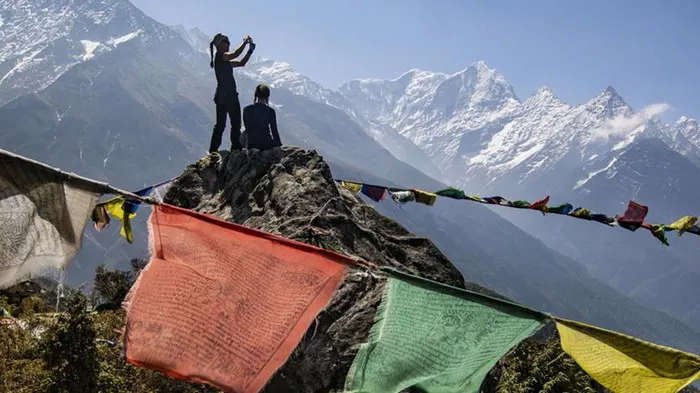Everest Base Camp is situated at an altitude of 17,038 feet (5,190 meters) above sea level. This makes it one of the highest points in the world that can be reached without specialized climbing equipment, accessible to trekkers who are prepared for the challenges of high-altitude hiking.
SEE ALSO: Where Are the Rocky Mountains?
Basic Information
Everest Base Camp is a staging area for climbers aiming to summit the world’s highest peak, Mount Everest. There are two main base camps: the South Base Camp in Nepal and the North Base Camp in Tibet. The altitude mentioned above refers to the South Base Camp, which is the more popular of the two and serves as the starting point for the Southeast Ridge route to Everest’s summit. The North Base Camp in Tibet is slightly lower, at around 16,900 feet (5,150 meters).
These base camps are not just resting points but crucial logistical hubs where climbers acclimatize to the altitude, gather supplies, and prepare for the grueling ascent. The camps are bustling with tents, supplies, and climbers, creating a temporary community of adventurers from around the globe.
Comparison to Other Elevations
To put the altitude of Everest Base Camp into perspective, consider some of the highest points in other parts of the world:
Denali (Mount McKinley), Alaska: The highest peak in North America, Denali stands at 20,310 feet (6,190 meters). The altitude of Everest Base Camp is roughly 3,272 feet (998 meters) lower than Denali’s summit.
Mont Blanc, France/Italy: The highest mountain in Western Europe, Mont Blanc rises to 15,777 feet (4,808 meters). Everest Base Camp is about 1,261 feet (384 meters) higher than Mont Blanc’s summit.
Mount Elbrus, Russia: The tallest mountain in Europe, Mount Elbrus stands at 18,510 feet (5,642 meters). While higher than Everest Base Camp, Elbrus’s base camps are significantly lower, with the highest camp sitting around 13,800 feet (4,200 meters).
In comparison to nearby towns:
Lukla, Nepal: The town of Lukla, where most Everest Base Camp treks begin, is at an altitude of 9,383 feet (2,860 meters). The journey from Lukla to Base Camp involves ascending nearly 7,655 feet (2,330 meters).
Kathmandu, Nepal: The capital of Nepal, Kathmandu, is at 4,600 feet (1,400 meters). From here to Everest Base Camp, trekkers gain an impressive 12,438 feet (3,790 meters) in elevation.
These comparisons highlight just how high Everest Base Camp truly is, standing well above many of the highest points in other regions of the world.
Impact of Altitude
Being at an altitude of 17,038 feet (5,190 meters) has significant physiological effects on the human body. At this height, the air contains approximately 50% less oxygen than at sea level, which can lead to a range of altitude-related issues.
One of the most common concerns is altitude sickness, also known as acute mountain sickness (AMS). Symptoms of AMS include headaches, nausea, dizziness, fatigue, and shortness of breath. In severe cases, altitude sickness can progress to more serious conditions like high-altitude pulmonary edema (HAPE) or high-altitude cerebral edema (HACE), both of which are life-threatening if not treated promptly.
Acclimatization is key to reducing the risk of altitude sickness. Climbers and trekkers spend several days at Everest Base Camp or other intermediate points to allow their bodies to adjust to the lower oxygen levels. It’s also important to ascend gradually, stay hydrated, and avoid overexertion.
Reaching Base Camp
Reaching Everest Base Camp is an adventure in itself and typically involves trekking through some of the most breathtaking landscapes on Earth. The most common route starts from Lukla, a small town with one of the world’s most famous (and challenging) airports. From Lukla, the trek to Everest Base Camp usually takes about 8-12 days, depending on the pace and acclimatization schedule.
The trek passes through several villages, including Namche Bazaar, a bustling market town that serves as the gateway to the high Himalayas. Along the way, trekkers cross suspension bridges, traverse steep trails, and are treated to stunning views of peaks like Ama Dablam, Lhotse, and, of course, Everest.
For those short on time or unable to undertake the trek, helicopter tours are available. These tours offer a quick, albeit expensive, way to experience Everest Base Camp and the surrounding mountains. However, the majority of adventurers prefer the traditional trek, which allows for a gradual acclimatization and a deeper connection with the region and its people.
Tips
The trekking season for Everest Base Camp typically runs from March to May and from September to November, when the weather is most favorable. During these times, the trails are busiest, and the base camp becomes a hive of activity. Permits are required for trekking in the Sagarmatha National Park, where Everest Base Camp is located, and these can be obtained in Kathmandu or through a trekking agency.
Logistics are an important consideration for anyone planning to trek to Everest Base Camp. Trekkers must be well-prepared with appropriate clothing, gear, and supplies, and should consider hiring a local guide or porter to assist with navigation and carrying heavy loads.
Conclusion
Everest Base Camp, standing at 17,038 feet (5,190 meters), is a remarkable destination that offers not only a physical challenge but also a profound sense of accomplishment for those who reach it. The altitude, though daunting, is manageable with proper preparation and acclimatization. Whether trekking or flying, reaching Everest Base Camp is an unforgettable experience that brings you closer to the world’s highest peak and the heart of the Himalayas.

